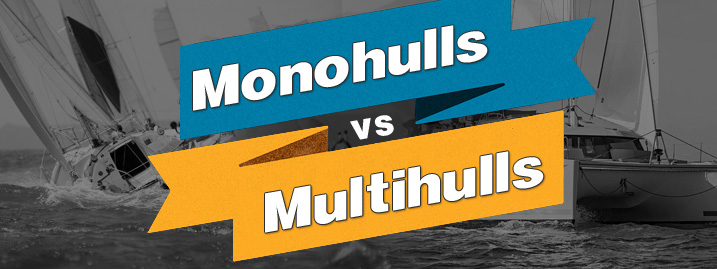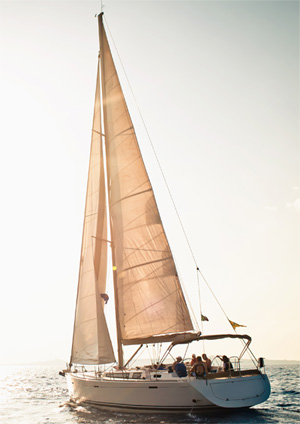
When you buy a boat you are probably making the largest financial outlay next to purchasing your house. You want and need to get it right and one of the first decisions will be, “do I choose a multi-hull or a mono-hull?” The most important considerations will be the three Ss – Safety, Stability and Speed.
Safety and Stability

Multi-hulls have become more and more popular because of their stability. Mono-hulls use heavy, weighted keels to keep themselves upright, whereas a multi-hull substitutes its breadth or beam for a heavy keel. Many people watching those little Hobie Cats zooming along on one hull and eventually capsizing get the impression that multi-hulls are dangerous. But a cruising multi-hull is different; the power-to-weight ratio is much lower and because of their reserves of buoyancy in the form of closed-cell foam, most will not capsize ever under intense conditions. It takes very high winds, too much sail and large breaking waves to flip over a modern cruising cat or tri but the amount of closed-cell foam can also create a serious fire hazard.
If the worst does happen it is important to stay with the boat; it will be more likely to stay afloat than a capsized and holed mono-hull. A well built mono-hull may roll badly or even capsize in a storm, but they generally pop back up, even if the rig has been swept away, providing a safe area to wait until the storm has passed. Once a multi-hull goes over she stays there. On the other hand if a mono-hull is holed it will sink like a stone. If one of the hulls of a multi becomes damaged, you still have the other one for buoyancy.
In the early years of multi-hull design the stresses of having two hulls several feet apart caused some serious problems and the breaking up of several vessels. Since then engineering has come a long way and the modern multi-hulls are now able to stand up to the adverse conditions required of them.
An interesting point is that Lloyd’s insurance policies for multi and mono-hulls of similar value are nearly the same.
The “heeling” or “non-heeling” characteristics of a boat are not just a matter of comfort. The heel of a mono-hull will soon tell you when the wind is picking up and that you are maybe carrying too much sail. With a multi-hull there is likely to be a delay before you get this message and you could sitting stable, sailing faster without realising that you are overpowered. This lack of heeling requires vigilance when it comes to reefing because almost all the wind force is converted to load on the rig. Pressure on the sails quadruples as the wind speed doubles, making it important that the sails are reefed in good time to keep the boat flat.
Some other aspects of safety which maybe overlooked are that with a level, non-pitching boat and a large cockpit it is much easier to keep the crew safe and aboard in rough weather. It could also be stated that a faster boat is a safer boat, so a multi-hull, which can go much faster than a mono, has the ability, with good weather routing, to place itself in the most favourable position to avoid the worst of the weather or to run before a storm. On the other hand a mono-hull may be preferable in short or single handed sailing because in a serious storm it can be hove-to until the storm blows itself out. A multi-hull requires very careful handling in serious storm conditions.
Speed

Here the multi-hull has an advantage because of its power-to-weight ratio and because most do not have the heavy keel of a mono-hull, a cruising catamaran is generally 25-30% faster than a similarly sized mono and a trimaran can double the sailing speed of a mono. However they cannot always point as high into the wind as a mono-hull, so they may reach an upwind destination at around the same time, because although they have travelled faster, they have sailed a greater distance. If, however, they are fitted with daggerboards, they may be able to point as high as a mono-hull. Another consideration is that a multi-hull will be more sensitive to loading, so that performance will suffer more on a heavily loaded cat than on a comparable mono-hull. With its extra space for equipment, toys and water tanks, it is a great temptation to load the multi-hull so much that the extra weight will cancel out the better performance. Another consideration is that its wetted surface will be greater than that of a mono and this creates more drag and will slow the boat down.
Sailing Characteristics
The basic operations of sailing multi and mono-hulls are the same, but there are a few differences.
- Tacking – Because of its wide beam and lack of weight, tacking a multi-hull can be difficult especially in light winds. Where in a mono-hull you would usually ignore the main, in a multi-hull you would sheet it in to help to steer the bow round and because of its light weight it will slow down very quickly when tacking. You may also have to backwind the jib to get the bow through the wind.
- Jibing – On a muti-hull the main will not react as violently on a jibe but it is still safer to centre it prior to jibing.
- Heeling – Here the multis shine as even when powered up, a cat or tri will rarely heel more than 5-10 degrees before you need to reef. Gone are the days of emptied cupboards and smashed crockery.
Comfort at Sea
Many sailors consider that multi-hulls are more comfortable at sea because of their lack of heeling and that they are less likely to roll from side to side as mono-hulls tend to do in some swells. Sea sickness is therefore less of a problem and walking around the vessel is generally easier and safer on a multi-hull, making sail changes and reefing easier and safer to do. The danger of falling overboard is considerably less on a multi and it is much easier to sleep on a boat which isn’t heeling. Stoves and ovens are often not gimbled simply because this is not necessary.
Some cats however do have quite a twitchy motion, especially going to windward, which can be disconcerting and sometimes unpleasant. Multi-hulls with low bridge deck clearance can be prone to pounding and slapping on the undercarriage when sailing upwind in lumpy, confused seas. In extreme seas it could feel as if the boat is getting pounded to pieces. Most mono-hulls do not pound in this manner. Those multis with larger bridge clearance and semi-rounded undercarriages seem to have overcome this problem.
Multi-hulls with two engines allow tremendous control in tight situations and can be spun almost on the spot or crabbed sideways. Prop walk is minimal or nonexistent and the second engine is a useful form of insurance if mechanical failure should arise.
Accommodation is an important factor and in this the multi-hull scores well if you intend to carry a large crew. For example, if you are catering for two families with children or teenagers, they can easily be accommodated in a 46ft cat along with all their paraphernalia like windsurfers, kites, surfboards and snorkelling kit.
Comfort at Anchor

The superior stability of a multi-hull means that crews can eat, sleep and live more comfortably when at anchor. With their greater width they provide enormous aft cockpits which are a great advantage in tropical climates. Their main salon is usually on the same level as the cockpit and provides a light filled area which can make cooking, reading, dining and navigating more pleasant. There is also more privacy on offer in a multi-hull due to the suites and heads being located in two separate hulls. One of the greatest advantages, however, must be their immunity to rolling at anchor in a swell, which may prohibit mono-hulls from anchoring in an otherwise idyllic spot. This dramatically widens one’s choice of anchorages.
Manoeuvrability
A modern catamaran with two engines can do a 360 turn in her own length, making her easier to dock than a single engine mono-hull, whereas a mono-hull has better manoeuvrability under sail and will certainly tack faster. In shallow areas the multi-hull is generally superior as they draw less water and can anchor in places a mono-hull would never consider, allowing them to anchor closer to beaches and explore shallow areas near to coastlines and reefs. Trimarans, with no keels at all, can even be beached.
Mooring in a Marina, Hauling and Storage
While multi-hulls are better at anchor, mono-hulls have a huge advantage when docking in a marina. Most multis, because of their extra width, have to be docked at the end of pontoons and there are many marinas that will not take multi-hulls at all, while mono-hulls can fit into much smaller spaces and raft up if necessary. Those that do take multis will obviously charge more. The beaminess of multis also greatly limits the number of shipyards that can haul them and lift them out of the water, so when it comes to repair and maintenance the monos will score.
Cost
Multi-hulls are very costly to build, due to their two or three hulls and their rigging and sails need to be stronger because they don’t heal and bleech off loads when hit by strong gusts of wind. If you buy from new, you will be able to find a greater variety of mono-hulls, at very much cheaper prices than multis. In the used market mono-hulls are relatively cheap to buy because supply outstrips demand, whereas choices of multi-hulls are very limited. If you are looking for a boat, say under about $150,000, there will be very few multi-hulls to choose from and under $100,000 the task will be almost impossible.
It is of course important to remember that if you buy a mono-hull cheaply you will also sell her even more cheaply, whereas multi-hulls will be more likely to hold their value much better if the present trend continues.
Which Do You Choose?
There are so many pros and cons for each! Many sailors choose mono-hulls for their romance and history, or simply because they have always sailed monos and are reluctant to change; others because they love the excitement of healing and battling with the wind. Some prefer the space, speed and flatness of the multi-hull. It really just comes down to a matter of individual preference and how and where you are going to use your boat. Over the past few years multi-hull sales have skyrocketed in North America, while they have been popular in France and South Africa for much longer. Ironically I have never ever sailed on a multi-hull, but in doing this research I found myself wondering if I had missed out. I would certainly like to try one out and, who knows, maybe multis will become my first choice.
Leave a comment below to what you would choose

Author - Dee White